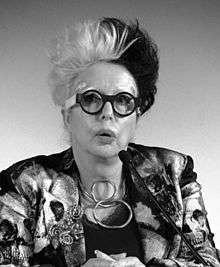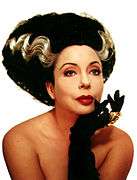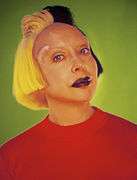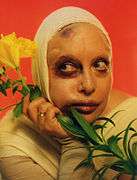Orlan
ORLAN (born Mireille Suzanne Francette Porte) is a French contemporary artist best known for her work with plastic surgery in the early to mid-1990s. She is known as a pioneer of carnal art, a form of self-portraiture that utilizes body modification to distort one's appearance. She adopted the pseudonym "ORLAN" in 1971.
ORLAN | |
|---|---|
 | |
| Born | Mireille Suzanne Francette Porte May 30, 1947 |
| Website | www |
She lives and works in Paris and sits on the board of administrators for the Palais de Tokyo, She was previously a professor at the École nationale supérieure d'arts de Cergy-Pontoise.
Biography
Early works
ORLAN's career as a performance artist began in 1964, when she performed Marches au ralenti (Slow motion walks) in her hometown of Saint-Étienne. During these performances, she would walk as slowly as possible between two central parts of the city. A year later, she produced MesuRages, in which she used her own body as a measuring instrument. With her "ORLAN-body" as the unit of measurement, she evaluated how many people could fit within a given architectural space. This was the first time she utilized her Trousseau, a set of household goods and other items traditionally provided to a young woman by her family upon her marriage, in a performance piece. Her Trousseau was re-purposed in a number of subsequent projects.
Between 1964 and 1966, she produced Vintages, a series of black and white photographic works. She destroyed the original negatives of these pieces, and today only one copy of each photograph remains. In this series, she posed naked in various yoga-like positions. One of the most famous pictures of this series is ORLAN accouche d'elle m'aime. She produced a body of work entitled Tableaux Vivants between 1967 and 1975, which she based on the works of prominent Baroque artists like El Greco and Gericault. In reference to Baroque art, she used inmates as models, wore exaggerated faux-Baroque costumes, and drew inspiration from Caravaggesque stereotypes. In 1971, she "baptized herself" Sainte-ORLAN, adorning herself with billowing black vinyl and white leatherette. Color photographs of Saint ORLAN were later incorporated into photo-collages, videos, and films tracing a fictive hagiography. Like her Tableaux Vivants, much of her work involving Saint ORLAN was directly inspired by Baroque art.
During the 1977 FIAC International Contemporary Art Fair in Paris, ORLAN executed controversial performance piece The Artist's Kiss (Le baiser de l'artiste). Outside the Grand Palais, a life-size photo of her torso was turned into a slot machine. Spectators could see the coin they inserted into the torso descend down into a groin before being awarded a kiss from the artist. The following year, she created Documentary Study: The Head of Medusa, in which the artist displayed her sexual organs during menstruation under a magnifying glass. The installation was organized in Aachen, Germany on occasion of an International Symposium of Performance Art at the Ludwig Forum for International art. The piece's title was derived from the statement by Sigmund Freud that "at the sight of the vulva, even the devil runs away," which he articulated in his short, posthumously-published essay entitled "Medusa's Head."
In 1978, she founded the International Symposium of Performance in Lyon. In 1982, she collaborated with artist Frédéric Develay to create the first online magazine of contemporary art, Art-Accès-Revue, on France's precursor to the Internet, the Minitel.
The Reincarnation of Saint-ORLAN
The Reincarnation of Sainte-ORLAN, a new project that started in 1990, involves a series of plastic surgeries through which the artist transformed herself into elements from famous paintings and sculptures of women. As a part of her "Carnal Art" manifesto, these works were filmed and broadcast in institutions throughout the world, such as the Centre Georges Pompidou in Paris and the Sandra Gehring Gallery in New York.[1] ORLAN's goal in these surgeries is to acquire the ideal of female beauty as depicted by male artists. When the surgeries are complete, she will have the chin of Botticelli's Venus, the nose of Jean-Léon Gérôme's Psyche, the lips of François Boucher's Europa, the eyes of Diana (as depicted in a 16th-century French School of Fontainebleau painting), and the forehead of Leonardo da Vinci's Mona Lisa. ORLAN picked these characters, "not for the canons of beauty they represent... but rather on account of the stories associated with them." ORLAN chose Diana, because she is inferior to the gods and men, but is leader of the goddesses and women; Mona Lisa, because of the standard of beauty, or anti-beauty, that she represents; Psyche, because of the fragility and vulnerability within her soul; Venus, for carnal beauty; and Europa, for her adventurous outlook on the future.[2]
Instead of condemning cosmetic surgery, ORLAN embraces it;[3] instead of rejecting the masculine, she incorporates it; and instead of limiting her identity, she defines it as "nomadic, mutant, shifting, differing." ORLAN has stated, "my work is a struggle against the innate, the inexorable, the programmed, Nature, DNA (which is our direct rival as far as artists of representation are concerned), and God!".[4]
"I can observe my own body cut open, without suffering!... I see myself all the way down to my entrails; a new mirror stage... I can see to the heart of my lover; his splendid design has nothing to do with sickly sentimentalities... Darling, I love your spleen; I love your liver; I adore your pancreas, and the line of your femur excites me." (from Carnal Art manifesto)
"Sainte ORLAN" came from a character that I created for "Le baiser de l'artiste" from a text called "Facing a society of mothers and merchants." The first line of this text was: "At the bottom of the cross were two women, Maria and Maria Magdalena." These are two inevitable stereotypes of women that are hard to avoid: the mother and the prostitute. In "Le baiser de l'artiste" there were two faces. One was Saint ORLAN, a cutout picture of me dressed as Madonna glued onto wood. One could buy a five francs church candle and I was sitting on the other side behind the mock-up of the vending machine. One could buy a French kiss from me for the same amount of money one could buy a candle. The idea was to play on the ambivalence of the woman figure and the desire of both men and women towards those biblical and social stereotypes. Being showcased in the Paris International Contemporary Art Fair, the artwork was somehow both an installation and a performance,"[5] said ORLAN, in her interview with Acne Paper.
 Portrait by Fabrice Lévêque in 1990.
Portrait by Fabrice Lévêque in 1990. Portrait by Fabrice Lévêque in 1997.
Portrait by Fabrice Lévêque in 1997. Portrait by Fabrice Lévêque in 1997.
Portrait by Fabrice Lévêque in 1997. Portrait by Fabrice Lévêque in 1997. Polaroid instant film.
Portrait by Fabrice Lévêque in 1997. Polaroid instant film.
Recent works
Since 1998, ORLAN has been creating a digital photographic series titled "Self-Hybridizations," where her face merges with past facial representations (masks, sculptures, paintings) of non-western civilizations. So far, three have been completed: Pre-Columbian, Native American and African.
In 2001, she orchestrated a series of filmic posters, "Le Plan du Film," with various artists and writers. The posters affirm the existence of films which do not actually exist. The posters question the notions of character and narrative reflected in the social reality of individual roles and stories.
In 2007, ORLAN collaborated with the Symbiotica laboratory in Australia, resulting in the bio-art installation "The Harlequin's Coat."
Part of her on-going work includes "Suture/Hybridize/Recycle," a generative and collaborative series of clothing made from Orlan's wardrobe and focusing on suture: the deconstruction of past clothing reconstructed into new clothing that highlights the sutures.
References
- Orlan 'Manifesto of Carnal Art/L'Art Charnel and Refiguration/Self-Hybridation series and other works' vol.12 July 2003 n.paradoxa: international feminist art journal pp.44-48
- Bernard Blistène; Christine Buci-Glucksmann; Regis Durand; et al. (2004). Orlan : [carnal art]. Translated by Deke Dusinberre (English lang. ed.). Paris: Flammarion. ISBN 9782080304315.
- Ferrando, Francesca (2016). "A feminist genealogy of posthuman aesthetics in the visual arts". Palgrave Communications (2): 7. Retrieved 6 July 2016. "ORLAN's work symbolically marks the passage between the seventies and the cyberfeminist nineties, fully embracing the possibilities opened by advanced technologies."
- Jeffreys, Sheila (2005). Beauty and misogyny : harmful cultural practices in the west (Reprinted. ed.). London: Routledge. ISBN 9780415351836.
- Mitrofanov, Oleg (2010). "Devotion – Orlan (Paris) – Artist". Acne Paper (9): 34.
External links
- Orlan Official Website
- Retrospective Exhibition from 05/25/07 to 09/16/07 at the Musée d'art moderne de Saint-Etienne
- Pompidou Centre, exhibition: elles@centrepompidou 2010.
- Video: interview with ORLAN, registration of a MesuRage, and short overview of her work at M HKA, Antwerp